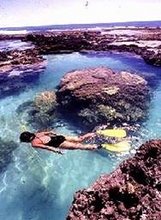
We never doubted it once. Fish sanctuaries do work if managed properly. After eight years of rehabilitation activities and close monitoring of the changes, the reef at Dive and Trek, San Pablo, Batangas has proven its worth to food security. The school of more than 2,000 jacks that grew in size due to the health of the reef migrated to deeper water and was reportedly caught by fisherfolks last year. It was said that approximately 30 tubs or banyeras (can accomodate as much as 50 kilos each)were caught.Divers and snorkelers who frequent the area may be dismayed by this, but it is actually a cause for celebration. The spill-over effect of a "no-touch" zone contributes to increase in fish catch. The reef is still in tip-top shape, with plenty of reef fish, thriving corals (despite the typhoon last December) and lots of tourists. The latter translate to economic benefit to the resorts catering to their needs, to the boat operators whose boats are rented for a trip to the sanctuary. Visitations also mean education, as more people learn about the reef and leave the place more connected with the natural world. This news is very encouraging to communities, resort owners and developers who wish to protect their "house reef" by going into reef rehabilitation. It fast tracks recovery of over fished and damaged reef areas. ECORE projects can be an excellent CSR (corporate social responsibility) initiatives of private corporations.








